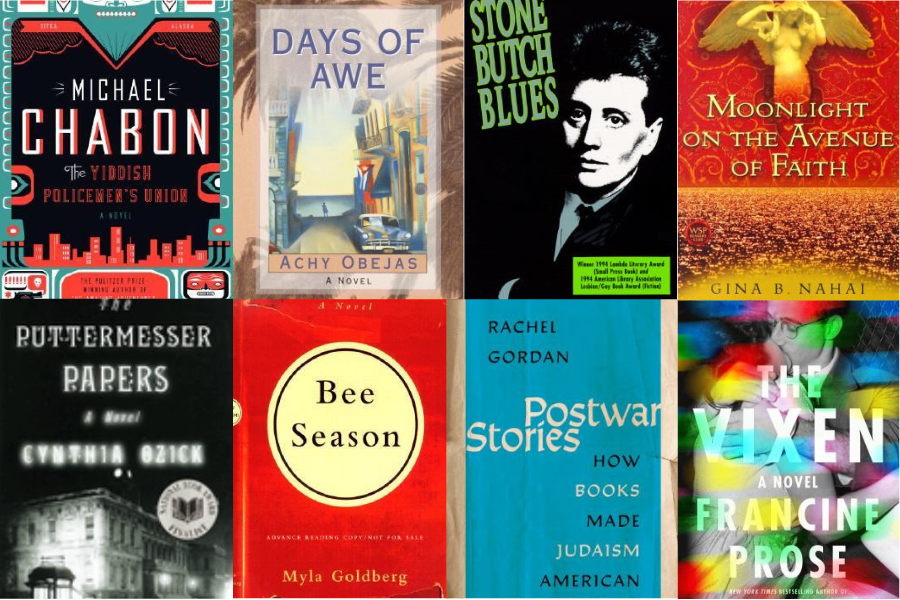Jewish American Heritage Month 2025: Jewish American Identity, Heritage and Culture Through Popular Fiction
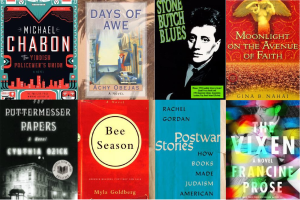
Post, Theme, and Recommended Reading Titles Curated by Lynn Lampert, Jewish Studies Librarian
What is Jewish American Heritage Month (JAHM)?
Following a series of annual presidential proclamations designating a week in April or May of each year as Jewish Heritage Week, President George W. Bush proclaimed May as Jewish American Heritage Month on April 20, 2006. Since 2007, Presidents Bush, Obama, Biden and Trump have all issued proclamations for Jewish American Heritage Month, which celebrate Jewish Americans and encourage all Americans to learn more about Jewish heritage and contributions to the United States.
Theme: Jewish American Identity, Heritage and Culture Through Popular Fiction
Fictional works that tell the stories of Jewish Americans have helped both Jewish Americans and non-Jewish Americans learn more about Jewish identity, culture, religion and heritage. As Rachel Gordon’s recent awarding winning book, Postwar Stories: How Books Made Judaism American (Oxford Press, 2024) points out, “It seems so obvious today to identify Judaism as a “religion” that it comes as a surprise to learn that it is only since the Second World War that Judaism has been widely considered a “religion” by most non-Jewish Americans. The consensus among American Christians before then was that Judaism was a race”. This changed with the war and, as Gordon argues, through the growth of popular fiction that examined Jewish American life. For this May 2025 Jewish American Heritage Month, the following titles from the CSUN University Library collection are recommended for readers wanting to learn more about how both very recent and older popular works of fiction have helped people, both non-Jewish and Jewish, learn about the Jewish American experience.  Postwar Stories: How Books Made Judaism American, by Rachel Gordan(New York: Oxford University Press, 2024)
Postwar Stories: How Books Made Judaism American, by Rachel Gordan(New York: Oxford University Press, 2024)
Available in print in the Gohstand Reading Room (E184.355.G6 2024)
Summary: “Postwar Stories brings the cultural achievements of two strands of midcentury middlebrow literature: anti-antisemitism novels of the 1940s and Introduction to Judaism literature of the 1940s and 1950s. While middlebrow literature did not cause societal change on its own, the books and magazine articles analyzed in Postwar Stories furnished an arena for articulating and questioning explanations of postwar American Jews and Judaism. For Jewish readers, depictions of Jews in anti-antisemitism and Introduction to Judaism literature were capable of providing reassurance or harm, depending on the associations and emotions they evoked. For young people coming of age in the late 1940s, reading a popular novel about antisemitism that became an Academy Award-winning film [Gentlemen’s Agreement starring Gregory Peck based on the novel written by Laura Z Hobson], or encountering a Life magazine story about Judaism could make a strong impression on their understanding of the significance of antisemitism and Judaism in American culture. Popular culture matters when studying American attitudes, because books, magazine articles, and films provide an intimacy to otherwise foreign subjects, making them personally meaningful to readers and viewers”– Provided by publisher.
Fun Facts: The novel Gentleman’s Agreement, was originally published in serial form in Cosmopolitan magazine in 1946, was published by Simon & Schuster, and became a runaway bestseller, selling over 1.6 million copies. It reached No. 1 on The New York Times Best Seller list in April 1947. The CSUN University Library also has a rare copy of Hobson’s Gentleman’s Agreement: A Novel) in Special Collections and Archives (Special Collections & Archives; PS3515.O1515 G4 1947b) 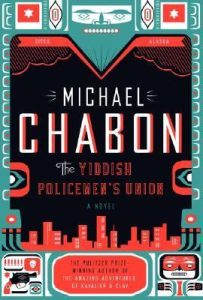 The Yiddish Policemen’s Union: A Novel, by Michael Chabon (First edition. New York: HarperCollins Publishers, 2007)
The Yiddish Policemen’s Union: A Novel, by Michael Chabon (First edition. New York: HarperCollins Publishers, 2007)
Available in print. Location: Floor4; PS3553.H15 Y54 2007
Author of the popular The Amazing Adventures of Kavalier & Clay, Michael Chabon’s The Yiddish Policemen’s Union tells the story of how, “For sixty years, Jewish refugees and their descendants have prospered in the Federal District of Sitka (Alaska), a “temporary” safe haven created in the wake of revelations of the Holocaust and the shocking 1948 collapse of the fledgling state of Israel. For sixty years they have been left alone, neglected and half-forgotten in a backwater of history. Now the District is set to revert to Alaskan control, and their dream is coming to an end. But homicide detective Meyer Landsman of the District Police has enough problems without worrying about the upcoming Reversion. His life is a shambles, his marriage a wreck, his career a disaster. In the cheap hotel where he has washed up, someone has committed a murder—right under his nose. Out of habit, obligation, and a sense of redemption, Landsman begins to investigate the killing of his neighbor, a former chess prodigy. But when word comes down from on high that the case is to be dropped immediately, Landsman soon finds himself contending with all the powerful forces of faith, obsession, hopefulness, evil, and salvation that are his heritage. Chabon’s novel is at once a gripping whodunit, a love story, an homage to 1940s noir, and an exploration of the mysteries of exile and redemption. Source: summary from BookRiot.com 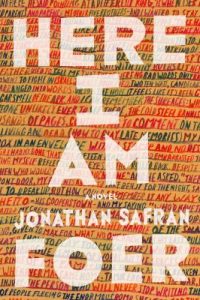 Here I Am by Jonathan Safran Foer (First edition. New York: Farrar, Straus and Giroux, 2016)
Here I Am by Jonathan Safran Foer (First edition. New York: Farrar, Straus and Giroux, 2016)
Available in print. Location: Gohstand Reading Room; PS3606.O38 H47 2016
Author of the highly popular novels Everything Is Illuminated and Extremely Loud and Incredibly Close (which were both adapted into successful films), Jonathan Safran Foer’s third novel, Here I Am is, “A novel of diaspora, of the elasticity of its numerous possible meanings, and of the pain caused by both the presence and the absence of the homeland it invokes. It moves from the intimate dissection of a family that has ceased to become a home for its members to the question of what Israel means to American Jews, and what they might consider to be their duty in the face of its imperilment” (Source: The Guardian). The novel artfully tells the story of a fracturing Jewish American family in a moment of crisis within their own home and within Israel. 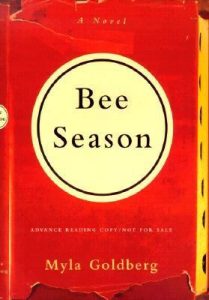 Bee Season: A Novel, by Myla Goldberg (1st ed. New York: Doubleday, 2000)
Bee Season: A Novel, by Myla Goldberg (1st ed. New York: Doubleday, 2000)
Available in print. Location: Floor4; PS3557.O35819 B44 2000
Summary: Eliza Naumann, a seemingly unremarkable nine-year-old, expects never to fit into her gifted family: her autodidact father, Saul, absorbed in his study of Jewish mysticism; her brother, Aaron, the vessel of his father’s spiritual ambitions; and her brilliant but distant lawyer-mom, Miriam. But when Eliza sweeps her school and district spelling bees in quick succession, Saul takes it as a sign that she is destined for greatness. In this altered reality, Saul inducts her into his hallowed study and lavishes upon her the attention previously reserved for Aaron, who in his displacement embarks upon a lone quest for spiritual fulfillment. When Miriam’s secret life triggers a familial explosion, it is Eliza who must order the chaos. Myla Goldberg’s keen eye for detail brings Eliza’s journey to three-dimensional life. As she rises from classroom obscurity to the blinding lights and outsized expectations of the National Bee, Eliza’s small pains and large joys are finely wrought and deeply felt.
Fun Fact: Bee Season was adapted into a 2005 American film and the screenplay was written by Naomi Foner Gyllenhaal (the mother of popular actor Jake Gyllenhaal). The film stars Richard Gere and Juliette Binoche. 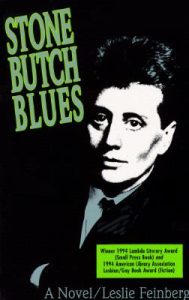 Stone Butch Blues: A Novel, by Leslie Feinberg (Ithaca, New York: Firebrand Books, 1993)
Stone Butch Blues: A Novel, by Leslie Feinberg (Ithaca, New York: Firebrand Books, 1993)
Available in print. Location: Floor4; PS3556.E427 S7 1993
Summary: Stone Butch Blues is an autobiographical novel by Leslie Feinberg that recounts the life of Jess Goldberg, a working-class butch Jewish lesbian in New York starting in the 1940s. The book is about being a lesbian in twentieth century New York, about Jess’ struggle with gender non-conformity and about the working class’s fight to unionize and gain power. Leslie Feinberg, described the book as a “bridge of memory.” Feinberg, who identified as an “anti-racist white, working-class, secular Jewish, transgender, lesbian, female, revolutionary communist,” devoted hir life to revolutionary causes including pro-Palestine justice work, antifascist and anti-KKK action, union organizing, and trans liberation. Zie was an activist in the Workers World Party and wrote several other books, including Trans Liberation and Transgender Warriors. At the heart of hir work was an emphasis on solidarity, radical love, and the documentation and remembrance of queer and communist histories. “Recovering collective memory [how groups remember their pasts] is itself an act of struggle,” Feinberg said in hir afterword to Stone Butch Blues. “It allows the generational currents of the white-capped river of our movement to flow together—the awesome roar of many waters.” (Summary from Jewish Women’s Archive: see “ Leslie Feinberg and the Power of Queer Jewish Memory”)
“Stone Butch Blues, Leslie Feinberg’s 1993 first novel, is widely considered in and outside the U.S. to be a groundbreaking work about the complexities of gender. Feinberg was the first theorist to advance a Marxist concept of “transgender liberation.” Sold by the hundreds of thousands of copies and also passed from hand-to-hand inside prisons, Stone Butch Blues has been translated into Chinese, Dutch, German, Italian, Slovenian, Turkish, and Hebrew (with hir earnings from that edition going to ASWAT Palestinian Gay Women). The novel was winner of the 1994 American Library Association Stonewall Book Award and a 1994 Lambda Literary Award” (Source: https://www.lesliefeinberg.net/). 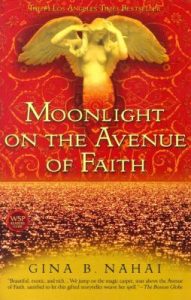 Moonlight on the Avenue of Faith by Gina Barkhordar Nahai (New York: Washington Square Press, 2000)
Moonlight on the Avenue of Faith by Gina Barkhordar Nahai (New York: Washington Square Press, 2000)
Available in print. Location: Floor4; PS3552.A6713 M66 2000
Summary: Gina Nahai (author of Cry of the Peacock, 1991) revisits Iran’s Jewish community as she tells the moving if not always engrossing tale of one woman’s struggle in a time of political turmoil. The saga of Roxanna begins in 1938 with her birth in Tehran’s ghetto and ends in 1980s Los Angeles. It is as much the story of a family increasingly affected by outside events as it is a low-key exploration of the conflict between destiny and choice. Nahai cuts early to the past, as the now-adult Lili recalls how, as a five-year-old, she saw her mother, Roxanna, grow wings and fly away. (Other clumsy flirtations with magical realism include sunflowers that give off light, sorrow that turns into body fat, and white feathers found after dreams of flight.) Warned that she is the “bad-luck one,” the eight-year-old Roxanna is given away to Alexandra, an eccentric Russian refugee. After Alexandra’s death, Roxanna flees the ghetto but finds herself trapped by love in a house on the “Avenue of Faith.” The house belongs to wealthy Teymur and his scheming wife; Roxanna marries their son Sohrab to be close to Teymur, whom she really loves. When their affair is discovered, she’s kept a prisoner in the house, and in desperation runs away, leaving Lili behind. Working first as a prostitute and then as kitchen help in Turkey, Sohrab sends Lili to school in Los Angeles. Then, as the Islamic revolution begins, Roxanna’s sisters flee to L.A.—where Lili, still mourning her mother, is unwillingly united with them, and eventually even with Roxanna, now bloated with sorrow and regret. Lots of action, local color, and adventure, but not enough to give Roxanna’s story the impact it demands. (Source: Kirkus Reviews)
Fun Facts: Moonlight on the Avenue of Faith, a novel by Gina B. Nahai, won the International Dublin Literary Award and the Harold U. Ribalow Award. It was also a finalist for the Orange Prize (now known as the Women’s Prize for Fiction). The book was also named one of the best books of the year by the Los Angeles Times.
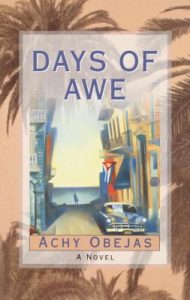 Days of Awe, by Achy Obejas (1st ed. New York: Ballantine Books, 2001)
Days of Awe, by Achy Obejas (1st ed. New York: Ballantine Books, 2001)
Available in print. Location: Gohstand Reading Room: PS3565.B34 D39 2001
Summary: “Days of Awe, Achy Obejas’s second novel and third book of fiction, centers on its Cuban American protagonist’s discovery of her family’s concealed Jewishness. At twenty-eight Alejandra San Jose believes both her parents to be loosely practicing Catholics. When she visits Cuba for the first time as an interpreter, ignorant of her Jewish roots, she is also dismissive and somewhat embarrassed by her Cuban heritage, [clinging to her difference from the natives, her superiority as an American woman. She “could care less about Cuba,” which to her is no more or less interesting than other countries she hasn’t seen yet. She flaunts her perfect American English, using body language to show her preference for the American speakers. Being Cuban, for her, is “an accident of timing and geography.” Then she meets the Menachs, old family friends who enlarge the boundaries of the known world for her—with regard not only to religion but sexuality, nationality, identity itself. The book’s title and central image, Days of Awe—the ten days between Rosh Hashanah and Yom Kippur in which the Almighty is deciding who will be written up in the “Book of Life”—is the darkest period in the Jewish year, with its focus on sin and atonement. It is this sense of sin and the quest for atonement that fuels the book. Even in the United States where Judaism can be practiced for the most part without undesirable consequences, Alejandra’s father won’t admit to being Jewish, while in his dark basement, in tallis and tefillin, he davens, weeping. Alejandra, who could live a comfortable American life, is increasingly drawn toward Cuba with its increasing poverty and hopelessness, where, in the face of her friends’ anger towards those who flee or who are free to come and go, she must continually justify herself. Summary Source: Shofar: An Interdisciplinary Journal of Jewish Studies via Project Muse database
Fun Facts: Days of Awe won the Lambda Literary Award in 2001 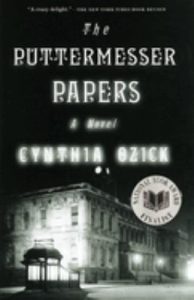 The Puttermesser Papers, by Cynthia Ozick (1st edition. New York: Alfred A. Knopf, 1997)
The Puttermesser Papers, by Cynthia Ozick (1st edition. New York: Alfred A. Knopf, 1997)
Available in print. Floor4: PS3565.Z5 P8 1997
Summary: NATIONAL BOOK AWARD FINALIST • The Puttermesser Papers follows Ruth Puttermesser, a highly learned woman living in New York City, who creates a female golem to fulfill her yearning for a daughter and becomes mayor, only to face the unintended consequences of her fantasies. In Jewish folklore, a golem is a man-made, animated being, typically crafted from clay or mud, and brought to life through magical or mystical means and typically golems can become uncontrollable or destructive. The novel combines elements of fantasy, historical fiction, and satire to examine how Ruth navigates her Jewish heritage, her personal experiences, and her role in modern life in America.,
The Vixen: A Novel, by Francine 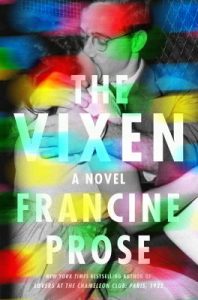 Prose. (First edition. New York, NY: Harper, an imprint of HarperCollins Publishers, 2021)
Prose. (First edition. New York, NY: Harper, an imprint of HarperCollins Publishers, 2021)
Available in print. Location: Second Floor Gohstand Reading Room: PS3566.R68 V59 2021
Summary: Prose’s novel takes place in 1953. Simon Putnam, newly hired by a distinguished publishing firm, gets his first assignment: editing a lurid bodice-ripper based on the recent trial and execution of Ethel and Julius Rosenberg. It is a potboiler intended to shore up the firm’s failing finances. Simon’s mother was a childhood friend of Ethel Rosenberg’s; his parents mourn Ethel’s death. Simon comes to realize that everyone is not what they seem, that everyone is keeping secrets, and that ordinary events may conceal a diabolical plot. (Source: Publisher)
Fun Fact: Author E.L Doctorow also wrote a famous novel centered on the execution of Julius and Ethel Rosenberg through the eyes of their son titled The Book of Daniel.
Available in print in CSUN’s stored collection and in Special Collections and Archives.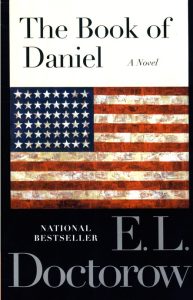 Summary: “In the silence of the library at Columbia University, where he is supposedly writing a Ph.D. dissertation, Daniel composes something quite different. It is a confession of his most intimate relationships — with his wife, his foster parents, and his kid sister Susan, whose own radicalism so reproaches him.It is a book of memories: riding a bus with his parents to the ill-fated Paul Robeson concert in Peekskill; watching the FBI take his father away; appearing with Susan at rallies protesting their parents’ innocence; visiting his mother and father in the Death House.It is a book of investigation: transcribing Daniel’s interviews with people who knew his parents, or who knew about them; and logging his strange researches and discoveries in the library stacks.It is a book of judgments of everyone involved in the case — lawyers, police, informers, friends, and the Isaacson family itself.It is a book rich in characters, from elderly grand- mothers of immigrant culture, to covert radicals of the McCarthy era, to hippie marchers on the Pentagon. It is a book that spans the quarter-century of American life since World War II. It is a book about the nature of Left politics in this country — its sacrificial rites, its peculiar cruelties, its humility, its bitterness. It is a book about some of the beautiful and terrible feelings of childhood. It is about the nature of guilt and innocence, and about the relations of people to nations” (Source: Jewish Book Council.org)
Summary: “In the silence of the library at Columbia University, where he is supposedly writing a Ph.D. dissertation, Daniel composes something quite different. It is a confession of his most intimate relationships — with his wife, his foster parents, and his kid sister Susan, whose own radicalism so reproaches him.It is a book of memories: riding a bus with his parents to the ill-fated Paul Robeson concert in Peekskill; watching the FBI take his father away; appearing with Susan at rallies protesting their parents’ innocence; visiting his mother and father in the Death House.It is a book of investigation: transcribing Daniel’s interviews with people who knew his parents, or who knew about them; and logging his strange researches and discoveries in the library stacks.It is a book of judgments of everyone involved in the case — lawyers, police, informers, friends, and the Isaacson family itself.It is a book rich in characters, from elderly grand- mothers of immigrant culture, to covert radicals of the McCarthy era, to hippie marchers on the Pentagon. It is a book that spans the quarter-century of American life since World War II. It is a book about the nature of Left politics in this country — its sacrificial rites, its peculiar cruelties, its humility, its bitterness. It is a book about some of the beautiful and terrible feelings of childhood. It is about the nature of guilt and innocence, and about the relations of people to nations” (Source: Jewish Book Council.org) 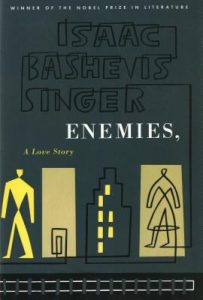 Enemies, a Love Story, by Isaac Bashevis Singer, Translated by Aliza Shevrin and Elizabeth Shub. (New York: Farrar, Straus and Giroux, 1972)
Enemies, a Love Story, by Isaac Bashevis Singer, Translated by Aliza Shevrin and Elizabeth Shub. (New York: Farrar, Straus and Giroux, 1972)
Available in print. Location Floor4; PJ5129.S49 S5913
Summary: Isaac Bashevis Singer wrote “Enemies, A Love Story” while living in New York City, specifically in the Upper West Side. He had settled there after emigrating from Poland in 1935. The novel tells the story of a Jewish refugee who escaped Hitler’s Holocaust and is living in New York with his second wife faces a dilemma when he discovers that his first wife is still alive. For many readers, Enemies, a Love Story was a first opportunity to see what Singer—most of whose previous novels were set in the villages and cities of Eastern Europe—would make of Yiddish-speaking Jews living in the postwar United States. (Summary excerpt from the Yiddish Book Center)
Note: Translated by Aliza Shevrin and Elizabeth Shub this novel was first published in The Jewish daily forward in 1966 under the title ‘Sonim, di Geshichte fun a Liebe.'”
The Length of a String, 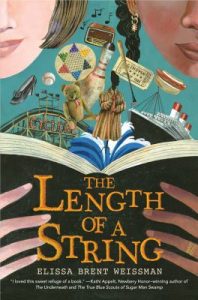 by Elissa Brent Weissman. (New York, NY: Dial Books for Young Readers, 2018)
by Elissa Brent Weissman. (New York, NY: Dial Books for Young Readers, 2018)
Available in print. Location: TCC – Display; PZ7.W448182 Le 2018
Summary: Twelve-year-old Imani, the only black girl in Hebrew school, is preparing for her bat mitzvah and hoping to find her birthparents when she discovers the history of adoption in her own family through her great-grandma Anna’s Holocaust-era diary. “Imani is adopted, and she’s ready to search for her birth parents. But when she discovers the diary her Jewish great-grandmother wrote chronicling her escape from Holocaust-era Europe, Imani begins to see family in a new way. Imani knows exactly what she wants as her big bat mitzvah gift: to find her birth parents. She loves her family and her Jewish community in Baltimore, but she has always wondered where she came from, especially since she’s black and almost everyone she knows is white. Then her mom’s grandmother–Imani’s great-grandma Anna–passes away, and Imani discovers an old journal among her books. It’s Anna’s diary from 1941, the year she was twelve and fled Nazi-occupied Luxembourg alone, sent by her parents to seek refuge in Brooklyn, New York. Anna’s diary records her journey to America and her new life with an adoptive family of her own. And as Imani reads the diary, she begins to see her family, and her place in it, in a whole new way.”–Publisher’s description.
 Marjorie Morningstar, by Herman Wouk (Garden City, New York: Doubleday & Company, Inc., 1955.)
Marjorie Morningstar, by Herman Wouk (Garden City, New York: Doubleday & Company, Inc., 1955.)
Available in print. Location: Stored; PS3545.O98 M3
Summary: Wouk’s novel tells the story of a starry-eyed young Jewish American beauty, Marjorie Morgenstern is nineteen years old when she leaves New York to accept the job of her dreams–working in a summer-stock company for Noel Airman, its talented and intensely charismatic director. Released from the social constraints of her traditional Jewish family, and thrown into the glorious, colorful world of theater, Marjorie finds herself entangled in a powerful affair with the man destined to become the greatest–and the most destructive–love of her life. Rich with humor and poignancy, Marjorie Morningstar is a classic love story, one that spans two continents and two decades in the life of its heroine. This unforgettable paean to youthful love and the bittersweet sorrow of a first heartbreak endures as one of Herman Wouk’s most beloved creations.” (Source: goodreads.com)
Fun Facts: Herman Wouk’s Marjorie Morningstar spent at least 37 weeks on The New York Times’ bestseller list, for months in the number one position. The novel was controversial among Jewish writers and religious figures as well as among secular intellectuals. The novel was later adapted into a popular film in starring Hollywood giants Gene Kelly and Natalie Wood. 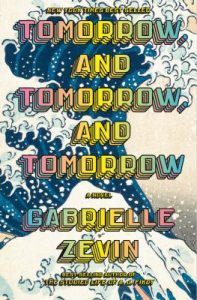 Tomorrow, and Tomorrow, and Tomorrow, by Gabrielle Zevin (First edition. New York: Alfred A. Knopf, 2024)
Tomorrow, and Tomorrow, and Tomorrow, by Gabrielle Zevin (First edition. New York: Alfred A. Knopf, 2024)
Available in print. Location: Gohstand Reading Room; PS3626.E95 T66 2022
Summary: Gabrielle Zevin’s highly popular 2024 novel Tomorrow, and Tomorrow, and Tomorrow is a “A modern love story about two childhood friends, Sam, raised by an actress mother in LA’s Koreatown, and Sadie, from the wealthy Jewish enclave of Beverly Hills, who reunite as adults to create video games, finding an intimacy in digital worlds that eludes them in their real lives, from the New York Times best-selling author of The Storied Life of A.J. Fikry“.
“The plot revolves largely around Sam and Sadie’s relationship as friends and collaborators. The growth and challenges they face as creative partners are integral to the story’s wider focus on how modern relationships are shaped by identity, privilege and power dynamics. Sam, who is a biracial Jew, was raised by his Korean grandparents, and spends much of his early life in working class conditions, fighting an uphill battle after being left physically disabled by a car accident that also killed his mother. He simultaneously respects and resents Sadie for her socioeconomically privileged background and upbringing. Meanwhile, Sadie struggles to make a name for herself in the world of game design as her accomplishments are constantly undermined by her relationship with powerful men in the industry. Zevin weaves a realistic narrative of what it’s like for people with overlapping social identities to thrive in a highly cutthroat environment” Source ( Gaw, K. Pacific Ties)
Fun Facts: This novel was recently named One of the New York Times’s 100 Best Books of the 21st Century and it spent over 44 weeks on The New York Times bestseller’s list with millions of copies sold worldwide.


